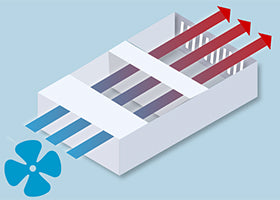
By Braden Cooper, Product Marketing Manager
The most powerful artificial intelligence computing hardware is designed to thrive in a datacenter environment where there is uncapped clean power, near limitless cooling capacity, and a vibration-free environment. The growth of AI use cases in vehicles including automated crop management, autonomous long-haul freight, and military ISR aircraft necessitates the use of datacenter-oriented hardware in vehicles – particularly for initial developments while more customized size, weight, and power (SWaP) optimized embedded platforms are developed. The transition from friendly environmental conditions to the rigors of the road require system designs which mitigate the thermal, structural, and other challenging environmental conditions of the transportable application. The thermal design is in a critical state – with the latest AI-oriented GPUs and CPUs reaching heat flux densities never before seen. Advanced thermal management designs provide a path to solving the heat flux challenge – but each come with advantages and disadvantages in implementation. This infographic highlights some of the methods which can be used to cool systems in AI transportable applications.

View larger as a pdf View text version
The best cooling method depends on many variables – from heat flux density to the SWaP constraints. With these existing technologies and ongoing industry innovation – powerful enterprise hardware can be used to solve the most demanding AI transportable challenges. The next few years are pivotal in the advancement of thermal management within datacenters – as immersion cooling and improved thermal interface materials see wider adoption. Transitioning these same cooling methods to AI Transportables solves the need for higher compute capacity at the location of data generation.
Click to share this blog post!
_______________________________________________________________________________________

By: Jaan Mannik – Director of Commercial Sales
The term AI, or Artificial Intelligence, is everywhere nowadays and has quietly woven itself into the fabric of our daily lives. It powers the recommendations we see on streaming platforms, the navigation apps that guide us through traffic, and even the virtual assistants that answer our questions in seconds. From optimizing energy use in smart homes to predicting market shifts in finance, AI has become the invisible engine driving convenience, efficiency, and insight across industries.
In manufacturing, AI-driven robots collaborate with humans to streamline production. In agriculture, machine learning models monitor crops, forecast yields, and conserve resources. Retailers use predictive analytics to anticipate consumer needs before customers even express them. The reach of AI is no longer confined to futuristic labs, it’s in our phones, vehicles, and cities, constantly learning and adapting to serve us better.

OSS PCIe-based products deliver critical advantages for modern military sensor systems by enabling real-time data acquisition, processing, and transmission in rugged, mission-critical environments. These benefits stem from their ability to support high-bandwidth, low-latency interconnects, modular scalability, and environmental resilience, all of which are essential for today’s advanced military platforms.

Companies today are being asked to do more with data than ever before. Bigger AI models, faster insights, and workloads that don’t stay in one place, it’s a lot to keep up with. Traditional infrastructure just isn’t built for this kind of speed and flexibility.
The answer isn’t about throwing more hardware at the problem. It’s about building smarter, more agile infrastructure that adapts as demands change. And that’s where scale-out and increasingly, a blend of scale-out and scale-up come into play.